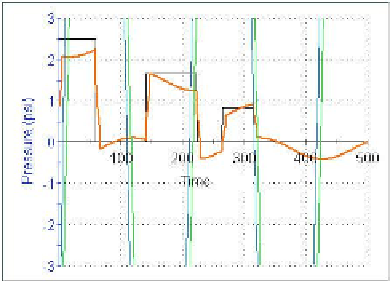Geology Reference
In-Depth Information
Figure 10.6b
. Recovery of three step pulses from
very
noisy environment.
10.1.6 Attenuation, distance and frequency.
The most important design questions in MWD relate to attenuation as it
depends on the combined and competing effects of fluid properties, drillpipe
geometry, signal generator characteristics and surface transducer specifications.
Let U represent fluid density, P the viscosity, c the sound speed, D the drillpipe
inner diameter and L the transmission distance along the pipe. If P
0
is the source
signal strength and P
xdcr
is the surface transducer sensitivity (that is, the smallest
detectable pressure after successful noise removal), then it can be shown that a
“critical carrier frequency” (expressed in Hertz) satisfies
f
crit
= Uc
2
D
2
(log
e
P
0
/P
xdcr
)
2
/(4SPL
2
) where the attenuation of plane waves propagating in a
laminar flow is modeled.
This critical frequency is the value necessary to support PSK or FSK
transmission over the assumed distance L. It provides the needed operational
bound; for frequencies
f
>
f
crit
, signal transmission is not possible. The formula
highlights several interesting physical features behind MWD wave propagation,
in particular, its dependence on the kinematic viscosity P/U and not on P alone,
not to mention the role played by pipe cross-sectional area (
~
D
2
).
Interestingly, a dimensionless pressure P
0
/P
xdcr
controls successful
reception. For instance, a 300 psi downhole source coupled with a surface
transducer unable to “see” with 1 psi resolution is less effective than a 100 psi
source working with a transducer having 0.25 psi capabilities. The strategy
required to optimize this ratio is obvious. First, reduce P
xdcr
as much as possible
by (a) using the most sensitive piezoelectric gauges available, (b) employing
effective
surface
noise cancellation methods such as those for Figures 10.6a,b,
(c) applying downhole reverberation algorithms as in Chapter 5, or perhaps, all
of the foregoing. And second, increase P
0
to the maximum extent permissible
by (1) using FSK schemes that take advantage of constructive wave interference,
(2) developing ganged sirens arranged in series, (3) optimizing siren geometries,

Search WWH ::

Custom Search